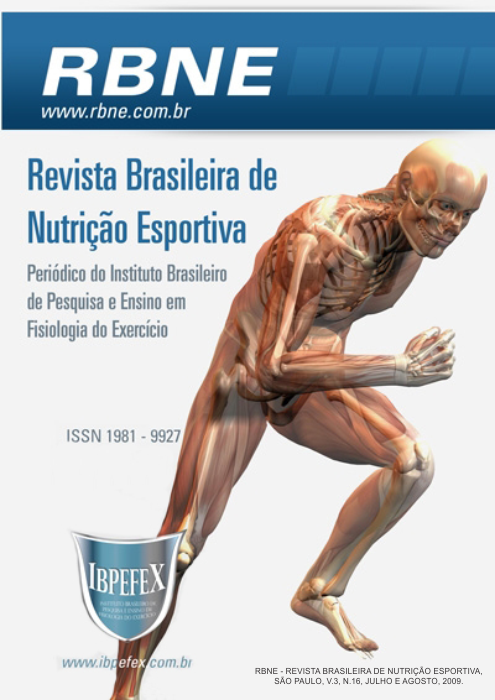Vitamin C as an antioxidant agent during endurance exercise
Abstract
The intensive physical exercise, especially aerobics cause stress in organism besides these actions cause free radical through different mechanisms which can cause muscular lesions and cellular damages. These lesions cause athletic problems in their performances. Vitamin C or aerobic acids participate in cellular processes of oxiduredution, working as a powerful natural antioxidant. The effect of nutritional supply in athletes with antioxidant nutrients, especially vitamin C has been largely discussing as a way of preventing or decreasing damages caused by exaggerated formation of free radical during physical practice
References
- Anderson, D. Antioxidant defences against reactive oxygen species causing genetic and other damage. Mutation Research. New York Vol. 350. Num.1. 1996. p.103-108.
- Alessio, H.M. Exercise-induced oxidative stress. Medicine and Science in Sports and Exercise. Indianápolis. Vol. 25. 1993. p. 218-24.
- Azulay, M.M.; Filgueira, L.A..; Mandarim-de-Lacerda, A.C.; Cuzzi, T.; Perez, A.M. Vitamina C. Anais Brasileiros de Dermatologia. Rio de Janeiro. Vol. 78. Num. 3. Maio/Junho 2003. p. 265-274.
- Cerutti, P.A. Oxidant stress and carcinogenesis. EuropeanJournal of Clinical Investigation.Holanda. Vol. 21. Num. 1. 1991. p.1-5.
- Clarkson, P.M.; Thompson, H.S. Antioxidants: what role do they play in physical activity and health? American Journal of Clinical Nutrition. Houston. Vol. 72. 2000. p. 637-647.
- Cruzat, F.V.; Rogero, M.M.; Borges, C.M. Tirapegui, J. Aspectos Atuais Sobre Estresse Oxidativo, Exercícios Físicos e Suplementação. Revista Brasileira de Medicina do Esporte. São Paulo. Vol.13. Num. 5. Setembro/Outubro 2007. p. 336-342.
- Bianchi, P.L.M.; Antunes, G.M.L. Radicais Livres e os Principais Antioxidantes da Dieta. Revista de Nutrição. Campinas (SP). Vol. 12. Num. 2. Maio / Agosto 1999. p. 123-130.
- Evans, W. Vitamin E, Vitamin C and Exercise. American Journal of clinical Nutrition. Houston. Vol. 72. 2000. p. 647-652.
- Goldfarb, A.H. Nutritional Antioxidants as therapeutic and preventive modalities in exercise-induced muscle damage. Canadian Journal Applied Physiology. Vol. 24. 1999. p. 249-266.
- Halliwell, B. Free radicals and antioxidants: a personal view. Nutrition Reviews. Vol. 52. Num. 8. 1994. p. 253-265.
- Halliwell, B.; Gutteridge, J.M.C. Free radicals in biology and medicine. 2a ed. 1994. New York: OxfordX.
- Horning, D. Metabolism and requirements of ascorbic acid in man. South African Medical Journal. Vol. 60. Num. 21. 1981. p. 818-823.
- Koury, J.C.; Donangelo, C.M. Zinco, estresse oxidativo e atividade física. Revista de Nutrição. Campinas. Vol. 16. Num. 4. 1981. p. 433-441.
- Niess, A.M.; Fehrenbach, E.; Schlotz, E.; Sommer, M.; Angres, C.; Tschositsch, K. Effects of RRR-á-tocopherol on leukocyte expression of HSP72 in response to exhaustive treadmill exercise. International Journal of sports Medicine. Vol. 23. Num. 6. 2002. p. 445-452.
- Novaes, M.R.C.G; Ito, M.K.; Arruda, S.F.; Rodrigues, P.; Lisboa, A.Q. Suplementação de micronutrientes na senescência: implicações nos mecanismos imunológicos. Revista de Nutrição. Campinas. Vol. 18. Num. 3. 2005. p. 367-376.
- Oliveira, E.M.; Ramires, P.R; Lancha, J. Nutrição e bioquímica do exercício. Revista Paulista de Educação Física. São Paulo. Vol. 18. 2004. p. 7-19.
- Padh, H. Vitamin C: never insights into its biochemical functions. Nutrition Reviews. Vol. 49. Num. 3. 1991. p. 65-70.
- Pinnel, S.R.; Murad, S.; Darr, D. Induction of collagen synthesis by ascorbic acid. A possible mechanism. Archives of Dermatology. Vol. 23. Num. 12. 1987. p.1684-1686.
- Sies, H.; Stahl, W. Vitamins E and C, b-carotene, and other carotenoids as antioxidants. American Journal of Clinical Nutrition. Houston. Vol. 62. Num. 6. 1995. p.1315-1321.
- Schneider, D.C.; Oliveira, R.A. Radicais Livres de Oxigênio e Exercício: Mecanismos de Formação e Adaptação ao Treinamento Físico. Revista Brasileira de Medicina do Esporte. Vol. 10. Num. 4. Julho/Agosto 2004.
- Souza, C.F.; Fernandes, L.C.; Cyrino, E.S. Produção de espécies reativas de oxigênio durante o exercício aeróbio e anaeróbio. Revista Brasileira de Cineantropometria & Desempenho Humano. Vol. 8. Num. 2. 2006. p. 102-109.
- Thompson, D.; Willians, C.; Garcia-Roves, P.; Mcgregor S.J.; Mcardle, F.; Jackson, M.J. Post exercise vitamin C supplementation and recovery from demanding exercise. European Journal of Applied Physiology. Vol. 89. 2003. p. 393-400.
- Tribble, D.L. Antioxidant consumption and risk of coronary heart disease: emphasis on vitamin C, vitamin E, and β-carotene: a statement for healthcare professionals from the American heart association. Circulation. Vol. 99. 1999. p. 591-595.
- Vancini, R.L.; Lira, C.A.B.; Aboulafia, J.; Nouailhetas, V.L.A. Radical livre, estresse oxidativo e exercício. Centro de estudos de fisiologia do exercício. Universidade Federal de São Paulo, 2005.
- Yu, B.P. Cellular defenses against damage from reactive oxygen species. Physiological Reviews. Vol. 74. 1994. p.139-162.
- Willians, M.H. Dietary supplements and sport performance: Introduction and vitamins. Journal of International Society of sports Nutrition. Vol. 1. Num. 2. 2004. p. 1-6.
Authors who publish in this journal agree to the following terms:
- Authors retain the copyright and grant the journal the right of first publication, with work simultaneously licensed under the Creative Commons Attribution License BY-NC which allows the sharing of the work with acknowledgment of the authorship of the work and initial publication in this journal.
- Authors are authorized to enter into additional contracts separately for non-exclusive distribution of the version of the work published in this journal (eg, publishing in institutional repository or book chapter), with acknowledgment of authorship and initial publication in this journal.
- Authors are allowed and encouraged to post and distribute their work online (eg, in institutional repositories or on their personal page) at any point before or during the editorial process, as this can bring about productive change as well as increase impact and impact. citation of published work (See The Effect of Free Access).






